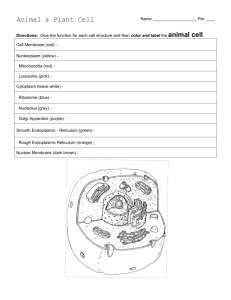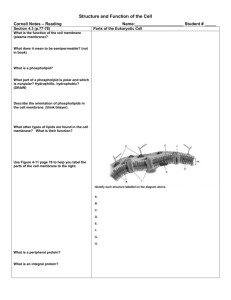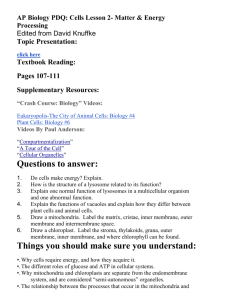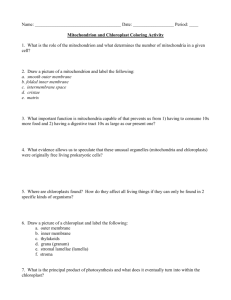project anatomy z
advertisement
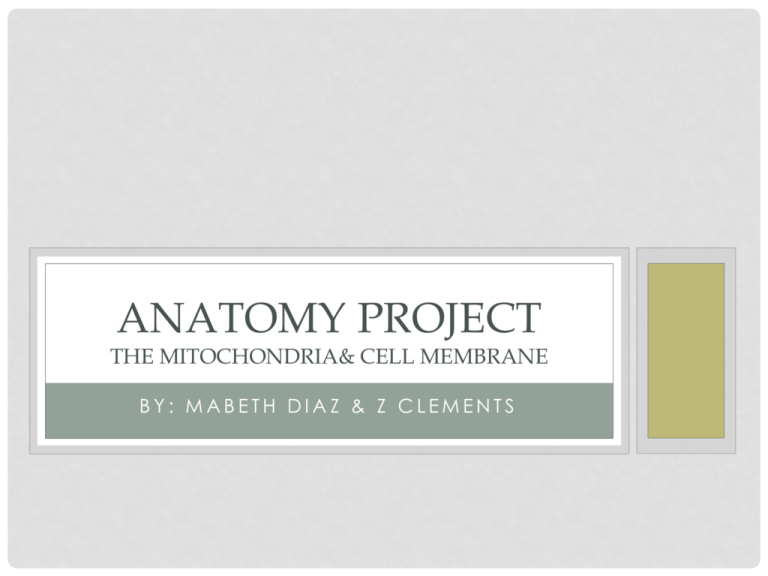
ANATOMY PROJECT THE MITOCHONDRIA& CELL MEMBRANE BY: MABETH DIAZ & Z CLEMENTS ANATOMY OF MITOCHONDRIA • The Outer Membrane of the Mitochondria is• freely permeable to small molecules and ions while the Inner Membrane is not permeable and contains a lot of proteins. • Towards the middle back of the Mitochondria, the ATP synthase particles occurs, which is an important enzyme that provides energy for the cell to use through the synthesis of adenine triphosphate (ATP). • In the middle of the Mitochondria, there is the Cristae, which increases the surface area and varies with oxidative capacity of tissue. • The matrix is what’s inside the mitochondria and it contains PDH and enzymes and contains Mitochondria’s DNA and RNA. • The Ribosomes are placed towards the bottom left of the Mitochondria and they link amino acids together in the order specified by the messenger RNA and they are also in the matrix design. • The matrix also consists of granules, which are at the bottom of the Mitochondria, granules appear to be involved with the ionic balance of the mitochondria. PHYSIOLOGY OF MITOCHONDRIA • Mitochondria are the cell’s power producers. They convert energy into forms that are usable by the cell . Located in the cytoplasm , they are the sites of cellular respiration, which ultimately generates fuel for the cell’s activities using glucose. • Cellular respiration is the set of metabolic reactions and processes that take place in the cells organisms to convert biochemical energy from nutrients into adenosine triphosphate (ATP), and then release waste products and this process is ultimately done by the glycolysis process as well as the electron transport chain. • Although carbohydrates, fats, and proteins are consumed as reactants, it is the preferred method of pyruvate breakdown in glycolysis and requires that pyruvate to enter the mitochondria in order to be fully oxidized by the Krebs cycle. • Mitochondria, subcellular organelles, serve as centers of genetic information, as central integrators of intermediary metabolism: oxidative phosphorylation, fatty acid oxidation, Krebs cycle, gluconeogenesis, urea cycle, ketogenesis. • Mitochondria are the main energy producers in the body from carbohydrates, fats and proteins, they are one of the main sites of reactive oxygen radical production, they play a crucial role in apoptosis, which is simply the automatic killing of cells. INTERACTIONS OF MITOCHONDRIA • Mitochondria are partially autonomous organelles that depend on the import of certain proteins and lipids to maintain cell survival and membrane formation. • The origin of most lipids imported into mitochondria is the endoplasmic reticulum, which requires interaction of these two subcellular compartments. • Several recent works show structurally and functionally dynamic contacts between mitochondria, the plasma membrane, the endoplasmic reticulum, and other subcellular organelles. • Many cellular processes require proper cooperation between the plasma membrane, the nucleus and subcellular vesicular/tubular networks such as mitochondria and the endoplasmic reticulum. • Such contacts are crucial for the synthesis and intracellular transport of phospholipids as well as for intracellular homeostasis, controlling fundamental processes like motility and contraction, secretion, cell growth, proliferation and apoptosis. ANATOMY OF CELL MEMBRANE • At the top of the cell membrane the Carbohydrate area evolves on the mitochondria and it helps convert food into useable energy. • Towards the surface area of the mitochondria the globular protein stands, which helps transport molecules across the cell membrane. • The Hydrophilic head group has a ‘special’ region that changes between various phospholipids. This head group will differ between cell membranes or different concentrations of specific ‘head groups’. • The glycolipids, which are at the front of the cell membrane, mainly have a communicative role, often acting as markers for cellular recognition. • The lipid bilayer has a critical role because its structural components provide the barrier that marks the boundaries of a cell. • On the bottom of the cell membrane there rests the hydrophobic tail, which differ from the hydrophilic head but there is always one saturated and one unsaturated ‘leg’ of the tail. • The Cholesterol is found on the bottom of the cell membrane and it’s especially abundant in the membranes of these cells, where it helps maintain the integrity of these membranes, and plays a role in facilitating cell signaling—meaning the ability of your cells to communicate with each other so you function as a human. PHYSIOLOGY OF CELL MEMBRANE • The flexible plasma membrane defines the barrier of a cell by separating two of the body’s major fluid compartments – the intracellular fluid within cells and the extracellular fluid outside cells. • The plasma membranes unique permeable structure allows it to play a dynamic role in cellular activities. There are two types of transports for the cell membrane, the passive and active transport. • The Passive transport uses simple diffusion, which is the random movement of particles, via gradients and facilitated diffusion via carriers. Diffusion is necessary because that’s how you get oxygen into your body and also get rid of things that we don’t need like carbon dioxide. There’s also osmosis which is simply diffusion of water across the semi-permeable membrane. Osmosis has a huge impact on the cells, depending on whether they are hypertonic, hypotonic, or isotonic which ultimately means either losing, gaining, or staying the same with the amount of water within the cell. The last part of passive transport would be facilitated diffusion which uses proteins to transport the glucose. • Active transport simply uses proteins and ATP for its transportation method. Active transport is ultimately the movement of molecules against their concentration gradients. The most famous type of active transport would be sodium potassium which moves sodium outside the cell and potassium inside the cell. INTERACTIONS OF CELL MEMBRANE • In the final stage of protein synthesis, the newly created protein is transported around the cell, again in Vesicles. Sometimes, the Vesicle may fuse with the Plasma Membrane and secrete the protein. • Many cellular processes require proper cooperation between the plasma membrane, the nucleus and subcellular vesicular/tubular networks such as mitochondria and the endoplasmic reticulum. THANKS For Time





